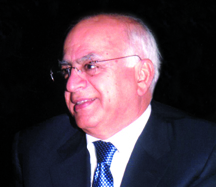‘Anti-seismic’ dinner table
a few days ago, i was invited to a luncheon held by the maronite association in kuwait at the beautiful st. regis hotel, on the occasion of st. maron’s day.
maron, or saint maron, as he is commonly known, was a hermit, monk, and priest who lived in northern syria during the fourth century ad. he is considered one of the most famous syrian syriac ecclesiastical figures, and is described as the founder, intercessor, and father.
b i s h o p youssef debs, the maronite archbishop of beirut, says in his book “the complete history of the original maronites,” which was published in the late 19th century, that the history of the maronites begins with a discussion of saint maron, who is considered the founder and patron saint of this sect, and that today there is no detailed biography or an accurate record of saint maron’s life and activities.
the testimony of the bishop of the region where saint maron practiced asceticism, theodoret, is considered the only basic reference about him, and how he was primarily responsible for spreading christianity in northern syria, where paganism was deeply rooted at the beginning of the fi fth century.
despite the lack of ancient references mentioning the biography of saint maron, the various studies and research conducted about him and the maronite church in general, especially following the founding of the maronite school in rome in the late sixteenth century, in addition to excavations and research operations north of aleppo in the late twentieth century, led to drawing a detailed picture of the life of saint maron and his church activities.
upon my arrival for the ceremony, the president of the association, brother joseph estephan, took me and sat me at the main table, the ten chairs of which were empty except for two clerics, the accredited sheikh of the mind of the unitarian druze sect in kuwait, sheikh nassib qansu, and bishop ghattas hazim, the metropolitan of baghdad, kuwait, and their dependencies.
i thanked him for my special seating place, and told him, jokingly, that our table had its share of clerics, many of whom i expected to arrive in succession!
i was not disappointed. moments later, the pastor of the melkite greek catholic church, archimandrite boutros gharib, came and took his place at our table. since he is a dear friend, it was natural for him to sit with us. then we were honored by the pastor of the maronite church in kuwait, al khor, bishop raymond eid, as he represents the head of the maronite church in the state, so it was a pleasure for him to sit at our table.
because of the wonderful and attractive composition of the “respected priests” at the table, the pastor of the armenian orthodox church, father ardak kayabani, and the patriarchal representative for kuwait and the neighboring armenian orthodox, bishop bedros manolia, did not hesitate to sit with us, perhaps because i am the only kuwaiti who wrote a novel about the suffering of the armenians, which was embodied in the novel “abdul latif al-armani”!
then bishop george abi saada of al khor graced the ceremony, representing his beatitude patriarch mar bechara boutros al-rahi, head of the maronite church in lebanon, and abi saada attended specifi cally for this occasion.
thus, i, known for my liberalism, was surrounded by the presence of brother ahmed arafa, the lebanese chargé d’affaires, and the host, brother estephan, with this wonderful mixture of seven clerics, whose presence was a source of reassurance that our table, in the event of a disaster, such as an earthquake, would be the safest, and no wonder it was the table that most attracted photographers.






